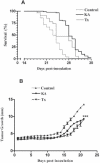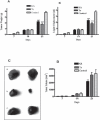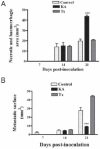Kaurenic acid: Evaluation of the in vivo and in vitro antitumor activity on murine melanoma
- PMID: 22144774
- PMCID: PMC3229785
- DOI: 10.4103/0253-7613.89826
Kaurenic acid: Evaluation of the in vivo and in vitro antitumor activity on murine melanoma
Abstract
Objective: The in vivo and in vitro antitumor activity of kaurenic acid [kaur 16-en-19 oic acid] (KA) in melanoma was evaluated in a murine model in comparison with taxol (Tx).
Materials and methods: B16F1 melanoma was developed in C57BL/6 mice and cell cultures. Survival test, tumor growth, dissected-tumor measurements, histology, cytoxicity assay on cultured cells, and changes of apoptotic gene expression at mRNA level were analyzed.
Results: KA showed antitumor effect in vivo and in vitro and compared with Tx, its antimelanoma activity was greater (P < 0.001). These results were confirmed by morphological analysis (P < 0.001). In melanoma cell cultures, KA IC(50) was 0.79 μM vs. 18.94 μM for Tx (P < 0.001). RT-PCR analysis demonstrated that Bcl-xL mRNA expression was altered in B16F1 mouse melanoma cells obtained from mice treated with either KA or Tx.
Conclusion: The data suggest that KA is active in animal melanoma models, both in vitro and in vivo, being its cytotoxic effects stronger than those exhibited by Tx. Further trials should be conducted to elucidate its mechanism of action in melanoma with respect to necrosis or apoptotic processes. Our results support other evidences indicating that KA is a potential chemotherapeutic agent against cancer that has to be widely explored.
Keywords: Antitumor activity; B16F1 melanoma; C57BL/6 mice; kaurenic acid.
Conflict of interest statement
Figures





Similar articles
-
On the anticonvulsant activity of kaurenic acid.Invest Clin. 2007 Sep;48(3):349-58. Invest Clin. 2007. PMID: 17853794
-
In vitro and in vivo antimelanoma effect of ethyl ester cyclohexyl analog of ethylenediamine dipropanoic acid.Melanoma Res. 2018 Feb;28(1):8-20. doi: 10.1097/CMR.0000000000000409. Melanoma Res. 2018. PMID: 29135861
-
Kaurenic acid: An in vivo experimental study of its anti-inflammatory and antipyretic effects.Indian J Pharmacol. 2010 Oct;42(5):293-6. doi: 10.4103/0253-7613.70205. Indian J Pharmacol. 2010. PMID: 21206621 Free PMC article.
-
Taurolidine induces apoptosis of murine melanoma cells in vitro and in vivo by modulation of the Bcl-2 family proteins.J Surg Oncol. 2007 Sep 1;96(3):241-8. doi: 10.1002/jso.20827. J Surg Oncol. 2007. PMID: 17469118
-
N-propionyl-4-S-cysteaminylphenol induces apoptosis in B16F1 cells and mediates tumor-specific T-cell immune responses in a mouse melanoma model.J Dermatol Sci. 2012 Jul;67(1):51-60. doi: 10.1016/j.jdermsci.2012.04.009. Epub 2012 May 2. J Dermatol Sci. 2012. PMID: 22622238
Cited by
-
Mechanistic Pathways and Molecular Targets of Plant-Derived Anticancer ent-Kaurane Diterpenes.Biomolecules. 2020 Jan 16;10(1):144. doi: 10.3390/biom10010144. Biomolecules. 2020. PMID: 31963204 Free PMC article. Review.
References
-
- Ghisalberti EL. The biological activity of naturally occurring kaurane diterpenes. Fitoterapia. 1997;4:303–25.
-
- Nagashima F, Kondoh M, Kasawe M, Simizu S, Osada H, Fujii M, et al. Apoptosis-Inducing Properties of ent-kaurene-type diterpenoids from the liverwort Jungermannia truncata. Planta Med. 2003;69:377–9. - PubMed
-
- Park SH, Nhiem NX, Kiem PV, Choi EM, Kim JA, Kim YH. A new norlupane triterpene from the leaves of Acanthopanax koreanum increases the differentiation of osteoblastic MC3T3-e1 cells. Arch Pharm Res. 2010;33:75–80. - PubMed
-
- Jung HA, Lee EJ, Kim JS, Kang SS, Lee JH, Min BS, et al. Cholinesterase and BACE1 inhibitory diterpenoids from Aralia cordata. Arch Pharm Res. 2009;32:1399–408. - PubMed
-
- Cavalcanti BC, Bezerra DP, Magalhaes HI, Moraes MO, Lima MA, Silveira ER, et al. Kauren-19-oic acid induces DNA damage followed by apoptosis in human leukemia cells. J Appl Toxicol. 2009;29:560–8. - PubMed
LinkOut - more resources
Full Text Sources
Research Materials

